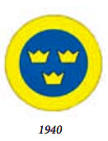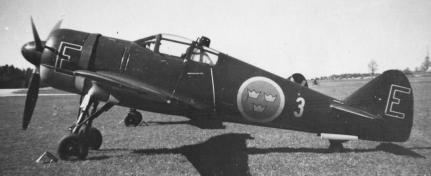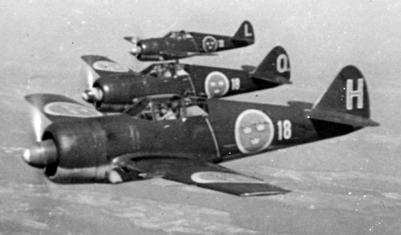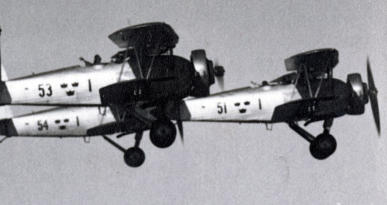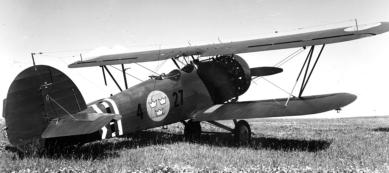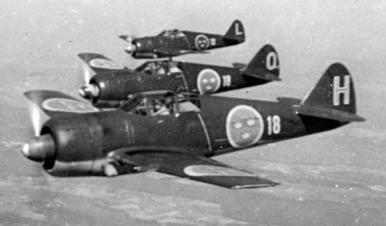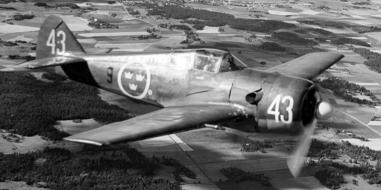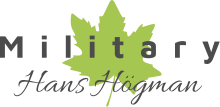

Copyright © Hans Högman 2022-06-12


Nationality Markings Used by
Military Aircraft of the Swedish
Air Force
Introduction
Army and Navy aircraft from 1914 carried the
Swedish naval ensign on the rudder and a yellow
roundel within a blue ring alongside the letter S
and, for the Navy, a number in black on the
underside of the lower wings. Already in 1915 the
blue-yellow cockade and the number were
removed and replaced by three black crowns on a
square white background. From 1917, the three
crowns would also be applied to the fuselage.
The 1927 Regulations
The Swedish Air Force was established as an
independent branch of the armed service on 1 July
1926. Previously, there were both Army and Navy
air services, which had their own rules for marking
the aircraft.
During a transitional period from the various
military air services to the formation of the Swedish
Air Force, a nationality marking was used consisting
of three white crowns with a black outline. On
the rudder, there was a painted vertical blue-yellow
band, with the front field yellow and the rear field
blue.
Air Force Order No. 5/1927 of January 1927 states:
•
Swedish military aircraft must bear a
nationality mark (crown mark and blue-yellow
mark) indicating the Swedish nationality of the
aircraft, and a registration mark (numbering
mark) indicating the number of the aircraft.
•
The crown mark shall consist of three black
crowns on a light background
according to the established model.
The background shall be circularly
bounded if the surface is otherwise
of a different color.
The crown mark shall be painted on the
underside of the lower wings and the upper
surface of the upper wings (in the case of
monoplanes on both sides of the wings) with
the upper part of the crowns facing the leading
edge of the wings and on the vertical sides of
the fuselage between the wing strut and the
stabilizer.
•
The blue-yellow mark shall be two equal,
vertical fields, covering the entire surfaces of
the rudder (on both sides) behind the rudder
shaft, the front field yellow, and the rear field
blue.
•
The numbering mark consists of the aircraft
number in black Arabic numerals.
The second, third, and any following digits
indicate the number of the aircraft within the
respective Air Corps/School.
The first digit indicates the corps or school to
which the aircraft belongs as follows:
o
Numeral 1 - 1st Air Corps
o
Numeral 2 - 2nd Air Corps
o
Numeral 3 - 3:rd Air Corps
o
Numeral 4 - 4th Air Corps
o
Numeral 0 - The Flight school (changed in
1929 to 5)
The image below shows reconnaissance aircraft
Heinkel HE 5, S 5, which was put into service in
1928. Nationality marking according to 1927
regulations.
The designation "256" means; aircraft 56 of the 2nd
Air Corps. Image: Sjöhistoriska museet, ID:
Fo220018.
The 1931 and 1932 Regulations
In 1932, new regulations were issued for the
marking of Swedish military aircraft. Air Force Order
No. 83/1932 of 28 October provided:
•
The nationality mark, i.e. the crown mark and
the blue-yellow mark, remains as it was before
(1927).
•
The numbering mark, consisting of the aircraft
number in black Arabic numerals, shall be as
follows:
- The first digit indicates the air corps where the
aircraft is located for accounting purposes as
previously (1927). However, the Staff Air Division
was allowed to use the number 6 as the first
digit.
- The third and fourth digits indicate the serial
number of the aircraft within the respective
aircraft type.
- The second digit should now indicate the type
and main use of the aircraft:
o
1 = Bombers, torpedo, and maritime
patrol aircraft
o
2 = Fighter aircraft
o
3 = Reconnaissance aircraft
o
4 = Reconnaissance aircraft
o
5 = Training aircraft
o
6 = Advanced training aircraft
o
7 = Transport aircraft
•
The aircraft registration number must now
always consist of 4 digits.
The image below shows a Hawker Hart, S 7, marked
with the designation number 1302 according to the
regulations of 1931/1932. The marking 1302
means; 1 = 1st Air Corps. 3 = reconnaissance
aircraft. 02 = aircraft serial number.
Image: Flygvapenmuseum, ID: FVMF.006090.
The 1935 Regulations
In the Air Force Order Fo 44/1935 from July 1935
and Fo no 74/1935 from October of the same year,
provisions were made that brought new changes.
Previous Go F12/1927 and Go F233/1932 were
repealed and new regulations were issued
regarding the marking of military aircraft as follows:
The nationality marking indicating the Swedish
nationality of the aircraft shall consist of two marks:
•
The Crown mark:
Three black crowns on a light background in
accordance with the established model: the
background must be circularly limited if the
surface is otherwise of a color other than light.
The crown mark shall be painted on the
underside of the lower wings and the upper
surface of the upper wings (in the case of
monoplanes on both sides of the wings) with the
tips of the crowns facing the leading edge of the
wings, and on the vertical sides of the fuselage
between the wing strut and the stabilizer.
•
The Blue-Yellow mark:
Two approximately equal vertical fields, covering
the whole of the rudder behind the axis of the
rudder, the front field yellow and the rear field
blue; the said colors being respectively gold-
yellow and light-medium blue, in accordance with
the Act concerning the flag of the Kingdom of 22
June 1906. The mark shall be painted on both
sides of the rudder.
Air unit designation indicating the aircraft's unit or
corps affiliation is placed in front of the crown
mark.
Numbering mark indicating the aircraft number.
•
The serial number of the aircraft is placed behind
the crown mark.
•
The registration number is given below the
stabilizer (the last three digits of the accounting
number).
The image below shows three bombers Hawker
Hart, B 4, of the F 1 Västmanland Air Wing in 1937,
marked according to the 1935 nationality
designation.
Closest to the front, 1 = F1 Västmanland Air Wing.
51 = aircraft serial number.
The second image shows the blue-yellow marking
on the rudder.
Image: Flygvapenmuseum, ID: FVMF.006088.
The 1937 Regulations
The Royal Air Administration (Kungliga
Flygförvaltningen, KFF) issued proposals on how
different types of aircraft would be painted in the
future and the Commander of Air Staff (Bengt
Nordenskiöld) wanted to introduce commanding
officers' marks on the aircraft.
Marking according to Fo No 47/1937 of 18 May
1937:
•
The nationality mark (i.e. the crown
mark) was placed on the fuselage.
Yellow crowns with a narrow black
border on a blue round base
(roundel).
•
Air wing number (unit designation) to
the left of the crown mark (the number 6 of the
Air Staff Division was taken over by the F 6 Air
Wing in 1938).
•
Aircraft serial number within the air unit to the
right of the crown mark and on both sides of the
nose.
•
Air unit insignia and command insignia on the
rear fuselage in front of the stabilizer.
•
Aircraft registration number as before but now in
front of the stabilizer.
The image below shows bomber Hawker Hart, B 4,
marked 27 of the F 4 Jämtland Air Wing. Marked
according to the 1937 regulations.
The "4" to the left of the crown mark stands for Air
Wing F 4. "27" is the serial number of the aircraft.
The three bands in front of the stabilizer are signs
of command.
Image: Flygvapenmuseum, ID: FVMF.002241.
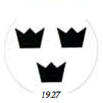
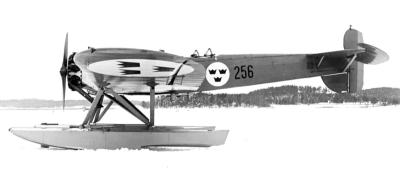

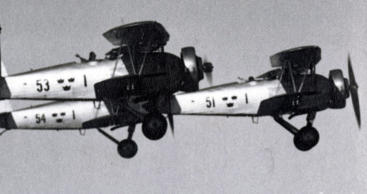

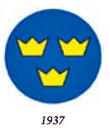

Swedish Militry Aircraft - 2
The 1940 Regulations
At Svea Air Wing F 8 (Barkaby) they believed that the
1937 regulations were not very good and started
their own tests with different markings.
After the Air Staff sent a consultation for comments
to the units regarding painting and marking, many
different comments were received which resulted in
a new general order as follows.
Extract from General Order Go No 248/1940 and Air
Force Order No 50/1940 (11/6):
Swedish military aircraft must be marked with a
designation consisting of the nationality designation,
serial number, and air unit designation.
•
The nationality insignia consists of
three yellow crowns surrounded by
a narrow black border on a blue
circular background, surrounded by
a yellow ring.
The nationality marking is placed on
the underside of the wings (not the upper sides)
with the tips of the crowns facing the leading edge
of the wing and on the sides of the fuselage
between the trailing edges of the wings and the
stabilizer (but after three reconnaissance aircraft S
16 Caproni were shot down in May-June 1944, it
was decided to reinsert the crown marking on the
upper side of the wing).
•
The aircraft number and air unit designation
consist of a numerical designation showing the
number of the wing and a numerical designation
showing the number of the aircraft and the
division to which the aircraft belongs:
o
1st division's warplanes receive numbers 1-15
o
2nd division's warplanes receive numbers 16-30
o
3rd division's warplanes receive numbers 31-45
o
Other aircraft 46 and above.
o
FKS (Air Force Flying School, F 5) aircraft are
numbered from 1 upwards.
The Air Wing unit designation number in black is
affixed to the fuselage to the left of the nationality
designation (no change).
The aircraft number in white (white or black for
training aircraft) is affixed to the fuselage in front of
the wings (nose) and to the rudder (also on the fin if
necessary).
Nothing was mentioned about the registration
number so there was no change.
Air unit designations and command insignia were
omitted as they could potentially entice the enemy to
take out commanding officers’ aircraft in the first
place.
The image below shows fighter aircraft FFVS J 22,
marked number 43 from F 9 Göta Air Wing in August
1944. Marked according to the 1940 regulations.
Black numeral nine = Air Wing number. Image:
Flygvapenmuseum, ID: FVMF.002110.
The 1944 Regulations
Especially Jämtland Air Wing, F 4, at Frösön was
dissatisfied with the current marking and got
permission to carry out tests with new markings and
submitted a report to the Chief of the Air Force (CFV)
in 1942, who then issued another referral regarding
marking. The answers received from the units all had
different suggestions.
New marking regulations were issued in December
1944, but no new General Order. Air Force Order
A65/1944 stated:
•
Nationality marking on the upper and lower wings
and both sides of the fuselage.
•
Air Wing unit designation became numbers in
yellow with placement behind the crown markings
on the fuselage.
•
The spinner (nose) on warplanes (not
reconnaissance) is painted in divisional color.
•
The above aircraft are provided with a letter code
in divisional color on the fin and nose.
o
Red = 1st division
o
Blue = 2nd division
o
Yellow = 3rd division
o
White = Air Wing Staff
•
Other aircraft use numbers in yellow (black on
white aircraft) instead of letters.
•
Registration number as before.
The image below shows fighter aircraft FFVS J 22,
marked number 3 (Östgöta Air Wing F 3) and "E".
Marked according to the 1944 regulations. Image:
Flygvapenmuseum, ID: FVMF.001991.
.
The 1949 Regulations
Confirming the practice, an Air Force Order
(A28/1949) was issued in October 1949. It provided
that the letters were to be "painted in the color of the
respective division with a white border except for yellow
lettering, on an aluminum colored surface where a dark
blue border is to be used".
The image below shows three fighter aircraft FFVS J
22 in the air belonging to Södertörn Air Wing F 18.
Marking according to 1949 regulations.
.
The 1955 Regulations
Air Force Order A6/1955 of 26 January is very similar
to the 1944 regulations:
•
The nationality mark as before (removed from the
upper surfaces of the wings in case of war).
•
Wing designation as before (possibly black on light
background).
•
The spinner is painted on both warplanes and
reconnaissance aircraft in divisional colors.
•
Letter code in divisional color on the fin and nose /
nose wheel hatch of warplanes and jet-powered
reconnaissance aircraft (not propeller-driven
reconnaissance aircraft).
•
Other divisional aircraft carry a numerical code
(last three digits of registration number) in white or
divisional color, located as above.
•
Other non-divisional aircraft (e.g. training aircraft
and liaison aircraft) are numbered in yellow and
located as above.
•
The registration number as before.
1959
However, in the case of centralized aircraft overhaul,
it was impractical to have a code system based on
divisional affiliation. When an aircraft was turned in,
another unit's aircraft were often returned as a
replacement, and it was untenable to keep re-
labeling aircraft all the time.
Therefore, Västmanland Air Wing F 1 started to use
the last two digits of the production number as the
code on the fin. During the design of the STRIL 60
system, it became clear that it was necessary to use a
two-digit code (not letters) on all warplanes.
STRIL 60 was a Swedish Tactical (Fighting Command)
and Air Defence Control System, initiated by the
Swedish Air Force and started to be expanded in the
1960s, replacing the earlier STRIL 50 system.
The 1964 Regulations
Air Force Order A11/1964 of 5 May states:
•
The nationality mark remains unchanged.
•
Army and Navy aircraft and helicopters would be
marked “ARMÉN” (Army) and “MARINEN” (Navy)
respectively. The Air Force did not need this
marking.
•
Color of the Air Wing marking: 'Dark' or 'Light'.
•
Fields in divisional color around the nose had to be
used.
•
Recognition mark (aircraft designation) on fin /
rudder, two dark or light numbers:
o
01-69 for jet aircraft (F 8 = 01-49)
o
71-99 other aircraft + helicopter (F 8 = 51-99)
o
F 5, Army and Navy: 01-99
•
Registration number unchanged.
As the marking was linked to STRIL 60, this time it was
much quicker to re-label the aircraft compared to
previously issued marking regulations.
The 1973 Regulations
Service announcement for the Armed Forces TKG
552:730289, 21 November:
•
– Crown markings unchanged (transport aircraft
may also have the text "SWEDISH AIR FORCE").
– The Air Force was now also allowed to use the
text "FLYGVAPNET" (Air Force) - Unit designation
unchanged - Recognition number unchanged (F 8
discontinued, F 16 01-94 for jet aircraft).
– Registration number unchanged.
– Anti-collision marking in fluorescent red-orange
on training and liaison aircraft.
•
Marking with divisional colors was no longer
allowed.
•
When the aircraft started to be painted in 4-color
camouflage, the yellow numbers on the fin were
replaced by red numbers in luminous color. At the
same time, the Wing number began to be placed in
front of the crown mark. Both measures were in
fact contrary to issued regulations.
•
New camouflage paint in light gray and dark gray
was so effective that flight safety was
compromised. In 1987, trials began with
large fluorescent markings on the wings
and fins.
In 1997, the color of the crown mark was
changed to gray (”low visibility”).
Air Division, Sweden
A division in the Swedish Air Force usually consists of
8 to 12 aircraft of the same type: for example fighter
division, attack division, reconnaissance division, etc.
Several divisions form a Wing.
